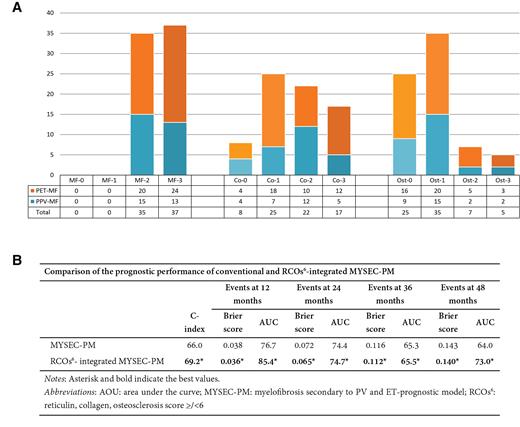Introduction: Polycythemia vera (PV) and essential thrombocytemia retain an inherent risk for progression to secondary myelofibrosis (SMF; PPV- and PET-MF, respectively). Histopathological examination of bone marrow (BM) biopsy constitutes an essential step in SMF diagnosis and can show a variety of stromal changes, including reticulin fibrosis, collagen deposition, osteosclerosis, and microvascular proliferation. In 2017, Gianelli et al. ( Histopathol 2017;71:89) developed a comprehensive, prognostically informative score, named reticulin (MF), collagen (Co), osteosclerosis (Ost) score (RCOs), aimed at the histological evaluation of primary MF (PMF).
Aims&Methods: This retrospective, single-center study aimed to validate the RCOs and explore its clinical, genetic and prognostic correlates in a cohort of patients (pts) with clinically and molecularly annotated SMF diagnosed according to the 2022 ICC criteria. The RCOs was assessed by two independent experienced histopathologists (U.G, R.S.), as previously described ( Histopathol 2017;71:89).
Results: The study included 72 pts with a diagnosis of SMF: 28 (39%) PPV-MF and 44 (61%) PET-MF. Median age at diagnosis was 66 years (range 35-85), 44 (61%) were male.
Histological analysis of BM stromal changes according to the RCO algorithm provided the following results (Fig. 1A): MF-0 n=0, MF-1 n=0, MF-2 n=35 (49%), and MF-3 n=37 (51%); Co-0 n=8 (11%), Co1 n=25 (35%), Co-2 n=22 (31%), and Co-3 n=17 (24%); Ost-0 n=25 (35%), Ost-1 n=25 (49%), Ost-2 n=7 (10%), and Ost-3 n=5 (7%). The corresponding figures for PPV- and PET-MF separately are reported in Fig. 1A. Overall, morphological features were homogeneously distributed with no significant differences between the two disease subtypes.
The computation of the RCOs returned the following results: RCOs 0 n=0, RCOs 1 n=0, RCOs 2 n=6 (8%), RCOs 3 n=15 (21%), RCOs 4 n=10 (14%), RCOs 5 n=9 (13%), RCOs 6 n=14 (19%), RCOs 7 n=9 (13%), RCOs 8 n=5 (7%), and RCOs 9 n=4 (6%). Median RCOs was 5 (range, 2-9) for both PPV- and PET-MF.
First, we investigated the correlations of the RCOs with distinct clinical and molecular characteristics in the whole SMF cohort. A higher RCOs was associated with lower hemoglobin value (Pearson's r, -0.3, P=.0173), lower platelet count (Pearson's r, -0.3, P=.0106), and higher LDH value (Pearson's r, 0.3, P=.0308). We found no significant correlations with regards to driver and other co-occurring mutations.
Median overall survival (OS) was 71 months (95% CI 45-99), with no significant difference between the PPV- and PET-MF cohorts. In univariate Cox regression analysis, the RCOs directly correlated with the risk of death (HR 3.9, 95% CI 1.2-13.8, P=.0282). In multivariate analysis, the predictive relevance of the RCOs was independent of the MYSEC-PM stratification. By analyzing the single components of the RCOs, both the MF and Ost variables correlated with survival (respectively: HR 3.9, 95% CI 1-12.9, P=.0315; HR 2.2, 95% CI 1.1-4.7, P=.0337), unlike the Co variable.
ROC analysis with death as endpoint identified 6 as the optimal cut-off value. Pts with RCOs >6 (n=32) had a significantly worst OS compared to pts with RCOs <6 (n=40), with median values of 42 vs 90 months (HR 2.5, 95% CI 1.3-5.2, P=.0097). ROC analysis separately in the PPV- and PET-MF cohorts returned 5 and 7, respectively. Due to the small study population, we opted to keep the two cohorts together and ascertained whether the integration of the dichotomous RCOs >/<6 (RCOs 6) improved the performance of the MYSEC-PM. To this end, we computed the C-index, Brier score, and time-dependent AUC to assess the prognostic performance of standard and RCOs 6-integrated MYSE-PM (Fig. 1 B). Overall, the combination of MYSEC-PM and RCOs 6 was remarkably superior in predicting death for all parameters and at all time points considered (24, 48, 72, and 96 months).
Conclusions: The results of the current study indicate that the RCOs, although formerly developed for pts with PMF, is clinically and prognostically relevant in SMF. Most importantly, we showed that integrating the discrete RCOs 6 into the SMF-specific MYSEC-PM can significantly improve the predictive performance of the prognostic model.
Disclosures
Guglielmelli:GSK: Speakers Bureau; Novartis: Other: Other member of advisory board, speaker at meeting, Speakers Bureau; Abbvie: Other: Other member of advisory board, speaker at meeting, Speakers Bureau. Vannucchi:Incyte: Membership on an entity's Board of Directors or advisory committees, Speakers Bureau; AbbVie: Membership on an entity's Board of Directors or advisory committees, Speakers Bureau; Novartis: Membership on an entity's Board of Directors or advisory committees, Speakers Bureau; BMS: Membership on an entity's Board of Directors or advisory committees, Speakers Bureau; Blueprint: Membership on an entity's Board of Directors or advisory committees, Speakers Bureau; GSK: Membership on an entity's Board of Directors or advisory committees, Speakers Bureau; AOP: Membership on an entity's Board of Directors or advisory committees, Speakers Bureau; Imago BioSciences, Inc., a subsidiary of Merck & Co., Inc., Rahway, NJ, USA: Research Funding.


This feature is available to Subscribers Only
Sign In or Create an Account Close Modal